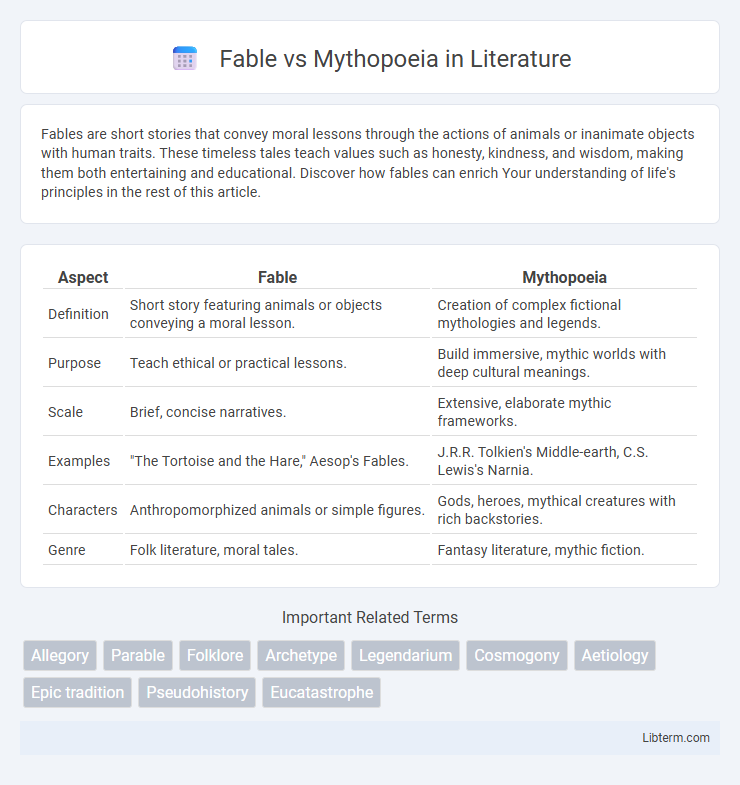Fables are short stories that convey moral lessons through the actions of animals or inanimate objects with human traits. These timeless tales teach values such as honesty, kindness, and wisdom, making them both entertaining and educational. Discover how fables can enrich Your understanding of life's principles in the rest of this article.
Table of Comparison
| Aspect | Fable | Mythopoeia |
|---|---|---|
| Definition | Short story featuring animals or objects conveying a moral lesson. | Creation of complex fictional mythologies and legends. |
| Purpose | Teach ethical or practical lessons. | Build immersive, mythic worlds with deep cultural meanings. |
| Scale | Brief, concise narratives. | Extensive, elaborate mythic frameworks. |
| Examples | "The Tortoise and the Hare," Aesop's Fables. | J.R.R. Tolkien's Middle-earth, C.S. Lewis's Narnia. |
| Characters | Anthropomorphized animals or simple figures. | Gods, heroes, mythical creatures with rich backstories. |
| Genre | Folk literature, moral tales. | Fantasy literature, mythic fiction. |
Defining Fable: Key Characteristics
A fable is a concise narrative that uses anthropomorphized animals or objects to convey moral lessons, often concluding with a clear, explicit message. Key characteristics include simplicity in plot, limited characters, and a focus on teaching ethical values through allegory. Unlike mythopoeia, which creates elaborate mythic worlds and complex narratives, fables prioritize direct, educational storytelling.
Understanding Mythopoeia: Core Elements
Mythopoeia involves the deliberate creation of an entire mythological framework, including gods, cosmogony, and cultural rituals, to convey profound philosophical or moral truths. It often employs symbolic archetypes and complex narratives that form a cohesive universe distinct from reality. Unlike fables, which typically deliver straightforward moral lessons through simple stories and anthropomorphic characters, mythopoeic works immerse audiences in richly layered legends that shape collective identity and worldview.
Origins and Historical Context
Fables originate primarily from ancient oral traditions, notably exemplified by Aesop's fables in Greek antiquity, serving as moral lessons conveyed through anthropomorphic animals. Mythopoeia, rooted in the myth-making processes of various cultures such as Norse, Greek, and Hindu civilizations, involves the deliberate creation of complex mythological worlds to explain natural phenomena and human experience. Both genres reflect early humanity's attempt to understand and communicate ethical, spiritual, and cosmological truths through narrative frameworks.
Purpose and Function in Storytelling
Fables serve to impart moral lessons through simple narratives featuring anthropomorphic animals or objects, making ethical teachings accessible and memorable. Mythopoeia creates complex mythologies that explain cultural beliefs, origins, and universal themes, enriching world-building and providing a shared identity for communities. The purpose of fables centers on clear, didactic messages, while mythopoeia functions to generate profound, symbolic frameworks that shape societal values and collective imagination.
Symbolism in Fables vs. Mythopoeic Works
Fables utilize simple, clear symbolism through anthropomorphic animals to convey moral lessons, making abstract concepts accessible and memorable. Mythopoeic works employ complex, layered symbolism rooted in cultural archetypes and cosmic themes, creating expansive narrative frameworks that explore existential and metaphysical questions. This distinction highlights the fable's function in ethical instruction versus mythopoeia's role in shaping mythic worldviews and collective identity.
Structure and Narrative Techniques
Fables employ a straightforward structure with concise storytelling and explicit moral lessons, often featuring anthropomorphic animals as characters to convey ethical messages effectively. Mythopoeia utilizes complex, multi-layered narratives with intricate world-building, embedding symbolic themes and mythic archetypes to create immersive, legendary tales. Narrative techniques in fables emphasize clarity and brevity, while mythopoeia leverages expansive prose and rich allegorical depth to explore profound cultural and existential concepts.
Famous Examples in Literature
A famous example of a fable is Aesop's "The Tortoise and the Hare," which uses animals to convey moral lessons through simple, direct storytelling. In contrast, mythopoeia is exemplified by J.R.R. Tolkien's "The Lord of the Rings," where an entire fictional mythology with its own languages, histories, and cosmology is created. Both literary forms serve different purposes: fables teach ethical principles concisely, whereas mythopoeia constructs expansive, immersive worlds that explore complex themes.
Impact on Culture and Society
Fables have significantly influenced cultural values and moral education by embedding practical life lessons within simple narratives that are easily remembered and passed down through generations. Mythopoeia shapes cultural identity by creating complex, symbolic universes that address existential questions and collective beliefs, often inspiring art, literature, and religious thought. Both forms enrich societies by fostering shared understanding, ethical frameworks, and imaginative exploration of human experience.
Modern Interpretations and Evolution
Modern interpretations of fable emphasize moral lessons delivered through anthropomorphic characters, often simplified for accessibility and educational purposes, reflecting societal values and ethical dilemmas. Mythopoeia, however, involves the creation of elaborate secondary worlds and complex mythologies that explore existential themes, cultural identity, and collective unconscious, as seen in works by J.R.R. Tolkien and Neil Gaiman. The evolution of both genres highlights a shift from traditional storytelling toward nuanced narratives that engage contemporary audiences through multimedia storytelling and intertextuality.
Choosing Between Fable and Mythopoeia for Writers
Writers choosing between fable and mythopoeia should consider the purpose and depth of their narrative; fables often use concise storytelling with clear moral lessons, ideal for imparting ethical values through simple characters and plots. Mythopoeia involves the creation of complex, immersive worlds with elaborate histories, cultures, and mythologies, providing rich material for exploring profound themes and philosophical questions. Selecting fable suits writers aiming for brevity and allegory, while mythopoeia benefits those seeking expansive world-building and intricate narrative layers.
Fable Infographic

 libterm.com
libterm.com